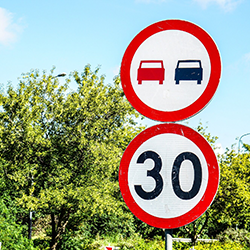Traffic management in residential areas, school zones, and high-pedestrian zones is critical for ensuring safety and reducing accidents. One of the most effective and widely used measures for traffic control is the installation of speed bumps and humps. These physical road alterations are designed to slow down vehicles, making streets safer for pedestrians and drivers alike. But how do speed bumps and humps work, and why are they so effective?
Understanding Speed Bumps and Humps
Speed bumps and humps are essential tools in traffic management, but they serve slightly different purposes and are used in different contexts. Let’s explore their characteristics and benefits:
What Are Speed Bumps?
Speed bumps are raised sections of pavement, typically 3 to 6 inches high and 1 to 3 feet wide. They are designed to force vehicles to slow down to very low speeds (around 5 mph) when driving over them. Speed bumps are most effective in parking lots, private roads, and areas where vehicles are expected to drive slowly.
What Are Speed Humps?
Speed humps are similar to speed bumps but are wider and more gradual. They typically span 10 to 14 feet in length and have a gentler rise and fall. This design slows vehicles to 10-20 mph, making speed humps suitable for public roads, residential streets, and school zones where a moderate speed reduction is desired without causing discomfort to drivers.
The Benefits of Speed Bumps and Humps
Enhanced Safety
The primary benefit of speed bumps and humps is the significant reduction in vehicle speeds, which directly correlates with a decrease in the likelihood and severity of accidents. Lower speeds give drivers more time to react to sudden obstacles, such as children darting into the street or other unexpected events.
Increased Pedestrian Protection
By slowing down traffic, speed bumps and humps create a safer environment for pedestrians. This is especially important in school zones and residential areas where children are present. The reduced vehicle speeds increase the reaction time for both drivers and pedestrians, leading to fewer accidents and injuries.
Improved Quality of Life
Lower vehicle speeds contribute to a quieter and more pleasant living environment. Reduced noise pollution from slower-moving vehicles makes neighborhoods more livable and enjoyable. Additionally, parents feel more comfortable letting their children walk or bike to school, promoting healthier lifestyles.
Cost-Effective Traffic Management
Compared to other traffic calming measures, speed bumps and humps are relatively inexpensive to install and maintain. Their cost-effectiveness makes them an attractive option for municipalities looking to improve safety on a budget.
Implementation Challenges
Emergency Vehicle Access
One concern with speed bumps and humps is their impact on emergency vehicle response times. Speed cushions, which have gaps allowing wider vehicles like fire trucks and ambulances to pass through without slowing down, can mitigate this issue.
Public Perception
Drivers may view speed bumps and humps as inconvenient. Public education campaigns that emphasize the safety benefits can help increase acceptance. Involving the community in planning and decision-making processes also fosters support.
Maintenance and Durability
Speed bumps and humps can wear down over time due to weather and constant use. Regular maintenance and the use of durable materials are essential to ensure their effectiveness.
Innovative Solutions for Traffic Control
As technology advances, new and improved versions of speed bumps and humps are being developed to address traditional challenges.
Dynamic Speed Bumps
Dynamic speed bumps adjust their height based on the speed of the approaching vehicle. They stay flat for vehicles traveling at safe speeds and raise to slow down speeding vehicles. This ensures that only speed violators are affected, reducing inconvenience for compliant drivers and emergency vehicles.
Smart Speed Humps
Smart speed humps integrate technology to collect data on vehicle speeds and traffic volume. This information can optimize traffic flow and improve safety measures. These humps can also adjust their height based on real-time traffic conditions, providing a more adaptable solution for traffic management.
Eco-Friendly Materials
Using recycled and sustainable materials for speed bumps and humps not only makes them environmentally friendly but also enhances their durability and reduces maintenance costs.
Conclusion
Speed bumps and humps are vital components of effective traffic management strategies. They enhance safety, protect pedestrians, improve the quality of life, and offer a cost-effective solution for controlling vehicle speeds. By addressing implementation challenges and leveraging innovative technologies, these traffic calming measures can be optimized for even greater effectiveness.
To learn more about how speed bumps and humps can enhance traffic safety in your community, visit
Unimat Industries.

